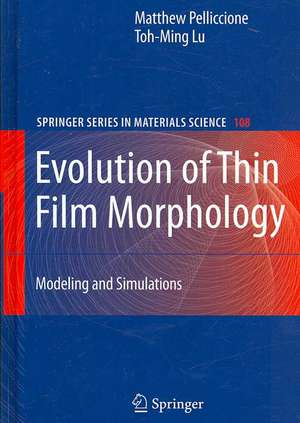Evolution of Thin Film Morphology: Modeling and Simulations: Springer Series in Materials Science, cartea 108
Autor Matthew Pelliccione, Toh-Ming Luen Limba Engleză Hardback – 30 noi 2007
| Toate formatele și edițiile | Preț | Express |
|---|---|---|
| Paperback (1) | 941.05 lei 6-8 săpt. | |
| Springer – 19 noi 2010 | 941.05 lei 6-8 săpt. | |
| Hardback (1) | 946.87 lei 6-8 săpt. | |
| Springer – 30 noi 2007 | 946.87 lei 6-8 săpt. |
Din seria Springer Series in Materials Science
- 18%
 Preț: 1820.22 lei
Preț: 1820.22 lei - 18%
 Preț: 776.09 lei
Preț: 776.09 lei - 24%
 Preț: 689.69 lei
Preț: 689.69 lei - 18%
 Preț: 968.96 lei
Preț: 968.96 lei - 20%
 Preț: 568.95 lei
Preț: 568.95 lei - 18%
 Preț: 953.65 lei
Preț: 953.65 lei - 18%
 Preț: 902.36 lei
Preț: 902.36 lei - 18%
 Preț: 953.65 lei
Preț: 953.65 lei - 20%
 Preț: 948.42 lei
Preț: 948.42 lei - 18%
 Preț: 1143.07 lei
Preț: 1143.07 lei - 18%
 Preț: 1111.53 lei
Preț: 1111.53 lei - 18%
 Preț: 1103.62 lei
Preț: 1103.62 lei - 18%
 Preț: 1225.94 lei
Preț: 1225.94 lei -
 Preț: 473.91 lei
Preț: 473.91 lei - 18%
 Preț: 782.42 lei
Preț: 782.42 lei -
 Preț: 433.47 lei
Preț: 433.47 lei - 18%
 Preț: 1116.40 lei
Preț: 1116.40 lei - 18%
 Preț: 946.24 lei
Preț: 946.24 lei - 18%
 Preț: 945.20 lei
Preț: 945.20 lei - 18%
 Preț: 1114.21 lei
Preț: 1114.21 lei - 15%
 Preț: 641.20 lei
Preț: 641.20 lei - 18%
 Preț: 958.56 lei
Preț: 958.56 lei - 18%
 Preț: 1224.36 lei
Preț: 1224.36 lei - 15%
 Preț: 644.82 lei
Preț: 644.82 lei - 24%
 Preț: 833.45 lei
Preț: 833.45 lei - 24%
 Preț: 1060.36 lei
Preț: 1060.36 lei - 18%
 Preț: 964.10 lei
Preț: 964.10 lei - 18%
 Preț: 1224.36 lei
Preț: 1224.36 lei - 18%
 Preț: 1221.20 lei
Preț: 1221.20 lei - 18%
 Preț: 1836.92 lei
Preț: 1836.92 lei - 15%
 Preț: 643.34 lei
Preț: 643.34 lei - 18%
 Preț: 1246.32 lei
Preț: 1246.32 lei - 18%
 Preț: 956.81 lei
Preț: 956.81 lei - 18%
 Preț: 953.52 lei
Preț: 953.52 lei - 15%
 Preț: 637.59 lei
Preț: 637.59 lei
Preț: 946.87 lei
Preț vechi: 1154.72 lei
-18% Nou
Puncte Express: 1420
Preț estimativ în valută:
181.20€ • 196.76$ • 152.21£
181.20€ • 196.76$ • 152.21£
Carte tipărită la comandă
Livrare economică 22 aprilie-06 mai
Preluare comenzi: 021 569.72.76
Specificații
ISBN-13: 9780387751085
ISBN-10: 0387751084
Pagini: 206
Ilustrații: XII, 206 p.
Dimensiuni: 210 x 297 x 14 mm
Greutate: 0.49 kg
Ediția:2008
Editura: Springer
Colecția Springer
Seria Springer Series in Materials Science
Locul publicării:New York, NY, United States
ISBN-10: 0387751084
Pagini: 206
Ilustrații: XII, 206 p.
Dimensiuni: 210 x 297 x 14 mm
Greutate: 0.49 kg
Ediția:2008
Editura: Springer
Colecția Springer
Seria Springer Series in Materials Science
Locul publicării:New York, NY, United States
Public țintă
ResearchCuprins
Description of Thin Film Morphology.- Surface Statistics.- Self-Affine Surfaces.- Mounded Surfaces.- Continuum Surface Growth Models.- Stochastic Growth Equations.- Small World Growth Model.- Discrete Surface Growth Models.- Monte Carlo Simulations.- Solid-on-Solid Models.- Ballistic Aggregation Models.- Concluding Remarks.
Textul de pe ultima copertă
Thin film deposition is the most ubiquitous and critical of the processes used to manufacture high tech devices. Morphology and microstructure of thin films directly controls their optical, magnetic, and electrical properties. This book focuses on modeling and simulations used in research on the morphological evolution during film growth. The authors emphasize the detailed mathematical formulation of the problem both through numerical calculations based on Langevin continuum equations, and through Monte Carlo simulations based on discrete surface growth models when an analytical formulism is not convenient. Evolution of Thin-Film Morphology will be of benefit to university researchers and industrial scientists working in the areas of semiconductor processing, optical coating, plasma etching, patterning, micro-machining, polishing, tribology, and any discipline that requires an understanding of thin film growth processes. In particular, the reader will be introduced to the mathematical tools that are available to describe such a complex problem, and appreciate the utility of the various modeling methods through numerous example discussions. For beginners in the field, the text is written assuming a minimal background in mathematics and computer programming. The book will enable readers themselves to set up a computational program to investigate specific topics of interest in thin film deposition.
Caracteristici
Presents basic modeling and simulation tools for quantitative description of thin film morphological evolution Displays clear conceptual developments in the fundamental understanding of complex surface growth phenomena Provides a close connection between modeling and simulations and various practical deposition methodologies Requires minimum mathematical and computer programming backgrounds to learn the subject







